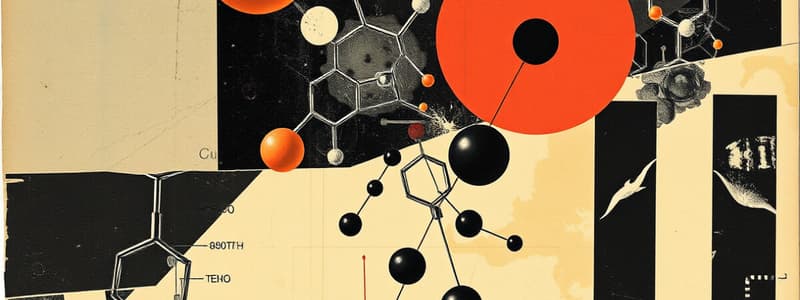Podcast
Questions and Answers
What type of bond exists between 2 nonmetals?
What type of bond exists between 2 nonmetals?
A binary covalent bond
What are 3 differences between ionic and covalent compounds?
What are 3 differences between ionic and covalent compounds?
- Ionic involves a metal and a nonmetal, while covalent involves 2 nonmetals. 2) Ionic steals electrons, covalent shares electrons. 3) Ionic can conduct electricity when dissolved, covalent is usually a poor conductor.
Does water share electrons equally, and what does this mean?
Does water share electrons equally, and what does this mean?
No, water does not share electrons equally; it is polar.
If H has an electronegativity of 2.1 and Cl has an electronegativity of 3.0, is the bond polar, nonpolar, or ionic?
If H has an electronegativity of 2.1 and Cl has an electronegativity of 3.0, is the bond polar, nonpolar, or ionic?
How do you name alkanes, alkenes, and alkynes?
How do you name alkanes, alkenes, and alkynes?
What are the prefixes for organic compounds 1-4?
What are the prefixes for organic compounds 1-4?
How can you tell if something is an alcohol?
How can you tell if something is an alcohol?
How do you name an alcohol?
How do you name an alcohol?
Why are valence electrons important?
Why are valence electrons important?
How many valence electrons do Ca, Si, Ar, K, and Te have?
How many valence electrons do Ca, Si, Ar, K, and Te have?
What's a polyatomic ion?
What's a polyatomic ion?
Is the compound WF2 ionic or covalent, and how do you know?
Is the compound WF2 ionic or covalent, and how do you know?
What is the difference between polar and nonpolar?
What is the difference between polar and nonpolar?
How can electronegativity determine if a compound is nonpolar, polar, or ionic?
How can electronegativity determine if a compound is nonpolar, polar, or ionic?
Ionic compounds have lines representing bonds in their Lewis dot diagrams.
Ionic compounds have lines representing bonds in their Lewis dot diagrams.
Flashcards are hidden until you start studying
Study Notes
Binary Covalent Bonds
- Formed between two nonmetals.
Differences Between Ionic and Covalent Compounds
- Ionic compounds include metals and nonmetals, while covalent compounds consist of nonmetals only.
- Ionic compounds involve the transfer of electrons; covalent compounds involve sharing of electrons.
- Ionic compounds can conduct electricity when dissolved; covalent compounds are generally poor conductors.
Water's Polarity
- Water is a polar molecule due to the unequal sharing of electrons.
Electronegativity and Polarity
- A compound with H (2.1) and Cl (3.0) is polar due to the difference in electronegativity.
Naming Organic Compounds
- Alkanes use the suffix -ane, alkenes use -ene, and alkynes use -yne, combined with prefixes.
Organic Compound Prefixes
- Prefixes for organic compounds include: Meth- (1), Eth- (2), Prop- (3), But- (4).
Identification of Alcohols
- Alcohols are characterized by the presence of an -OH "tail".
Naming Alcohols
- Alcohols are named by the prefix + -yl + alcohol, adjusting the alkane name by subtracting -e and adding -ol.
Importance of Valence Electrons
- Valence electrons are crucial for determining bonding and chemical reactivity.
Valence Electrons in Specific Elements
- Calcium (Ca): 2, Silicon (Si): 4, Argon (Ar): 8, Potassium (K): 1, Tellurium (Te): 6.
Polyatomic Ions
- Comprised of multiple atoms that collectively carry a charge.
Identifying Compounds (WF2)
- WF2 is an ionic compound as it contains a metal (W) and a nonmetal (F).
Polar vs Nonpolar Compounds
- Polar compounds do not share electrons equally; nonpolar compounds share electrons equally.
Using Electronegativity to Determine Compound Type
- Determine bond type by subtracting electronegativities:
- 0-0.4: Nonpolar
- 0.4-2.0: Polar
- Greater than 2.0: Ionic
Ionic Compounds in Lewis Dot Diagrams
- False: Ionic compounds are not represented with lines for bonds in Lewis dot diagrams; covalent compounds are.
Studying That Suits You
Use AI to generate personalized quizzes and flashcards to suit your learning preferences.




